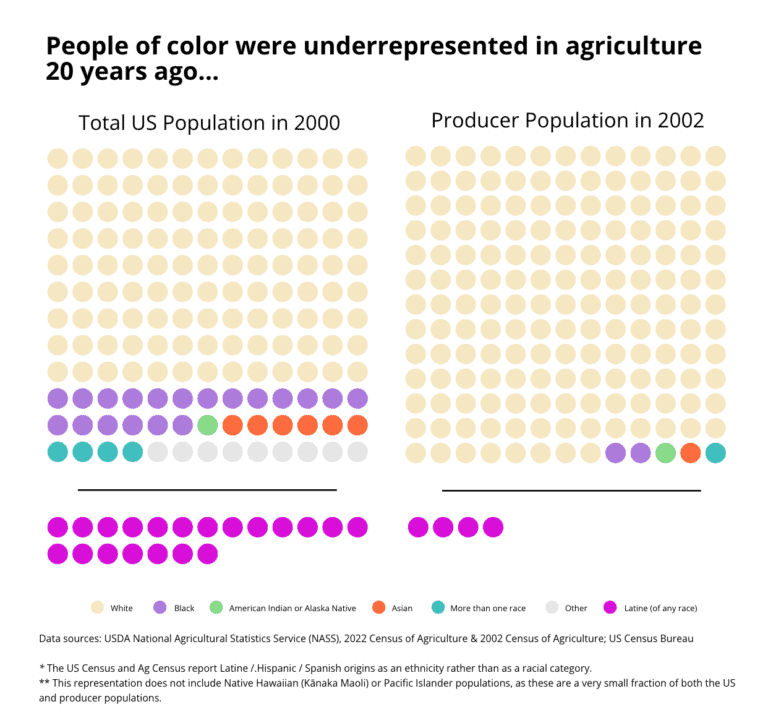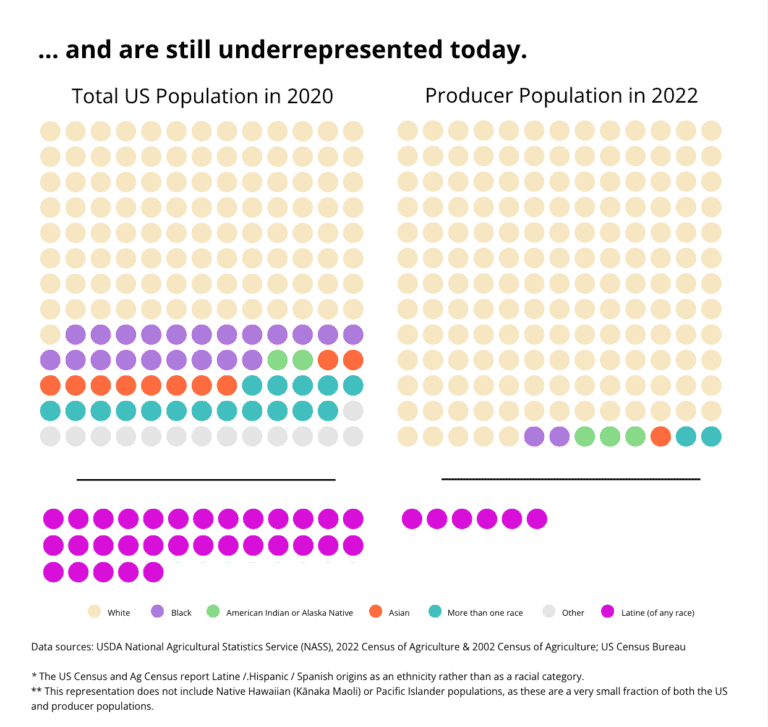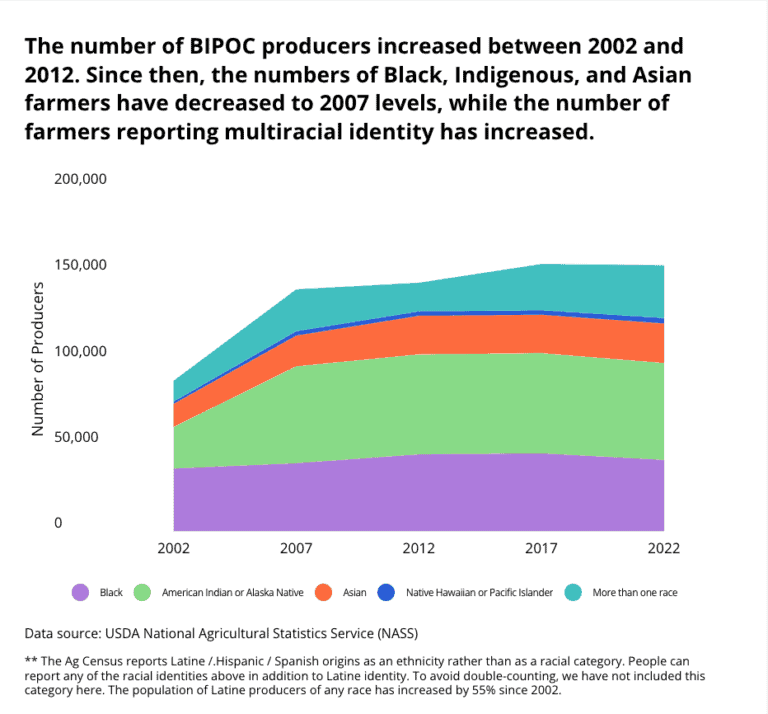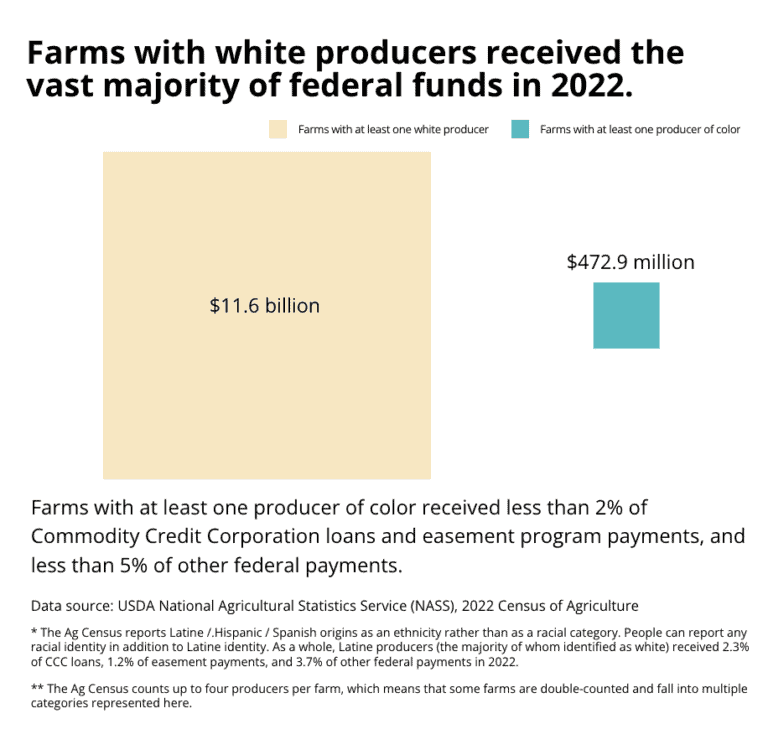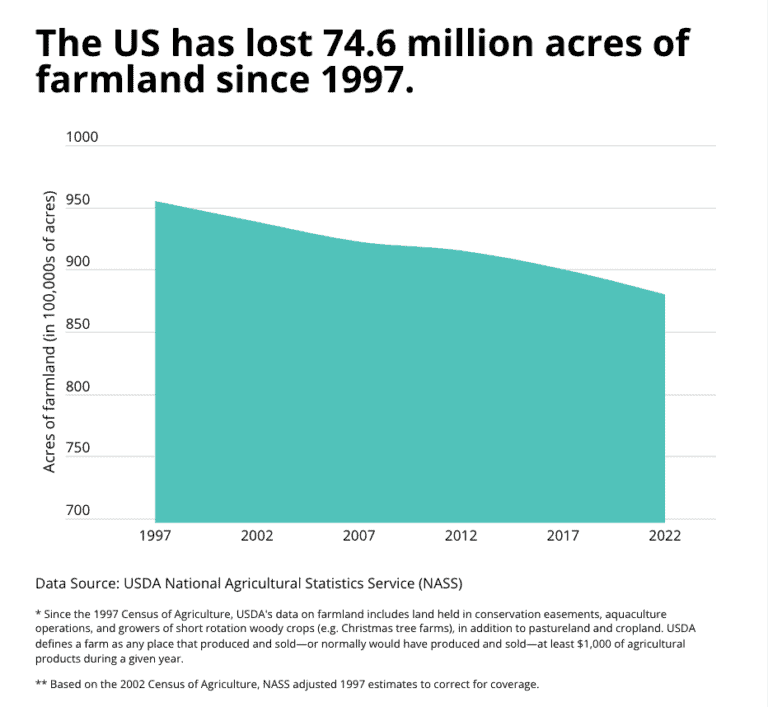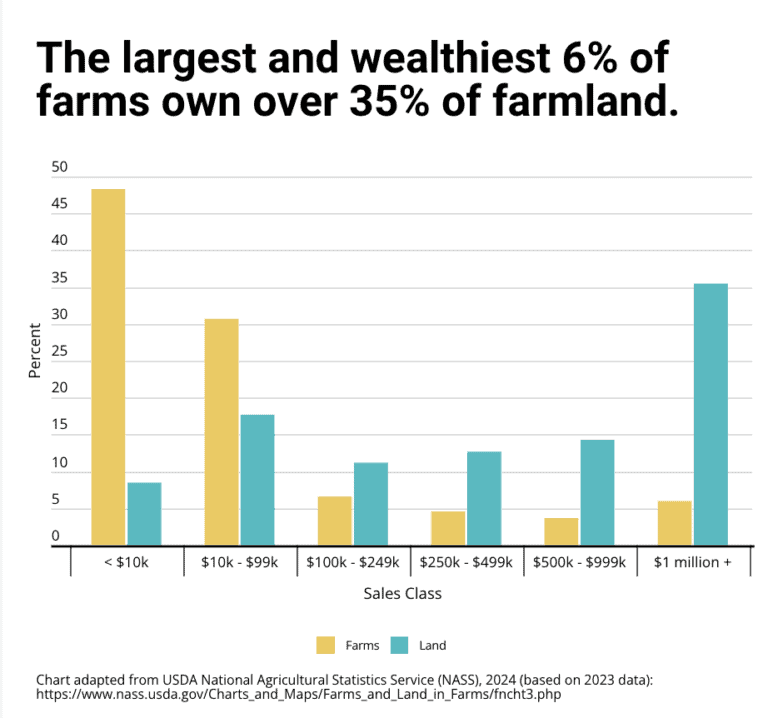By Ashley Fent, Campaigns Researcher
Producers of color face a farm economy that remains overwhelmingly white and is increasingly dominated by larger, fewer, and more industrialized farms, according to the 2022 Census of Agriculture, released in February 2024. Conducted every five years by the United States Department of Agriculture (USDA), the Ag Census is a survey of all of the nation’s farms and the people who run them. It provides a detailed picture of trends within US agriculture, from environmental practices and farmland loss to the demographics of those who grow our food.
At HEAL Food Alliance, our analysis of the census data supports our demands for the Farm Bill, which include the need for the USDA to improve land and credit access for producers of color and protect small farmers across the country from farmland consolidation.
Here are some of our key takeaways:
1. Producers of color are still dramatically underrepresented in agriculture
The Ag Census shows that people of color continue to be underrepresented in agriculture. Although Black people made up 12.4% of the total US population as of the 2020 Census, they were only 1.24% of its farmers as of 2022. Those identifying as Asian make up 6% of the population but only 0.68% of farmers. And people identifying as more than one race make up 10.2% of the population but only 0.9% of farmers. Meanwhile, white people — who make up only 61.6% of the population — are 95.4% of farmers. What’s more, this pattern has not substantially improved over the past 20 years, even as the country’s population has become more diverse.
Over the five years from 2017 to 2022, the number of Black, Indigenous, and People of Color (BIPOC) growers decreased by 0.5%. In particular, Black growers have been pushed out of or left farming at a rate higher than any other racial group, with an 8% decrease since 2017. Depending on the definition used, this rate is nearly twice or quadruple the rate of the next most adversely affected group.* Some racial groups saw modest increases in the number of producers: multiracial growers increased by 14.3% and Kānaka Maoli (Native Hawaiian) and Pacific Islander growers increased by 13.2%. But all of the increase in the latter group was in the continental United States (in Hawai’i, numbers have actually decreased). And because the baseline numbers for these populations were so small to begin with, these percentage increases represent a fairly small number of new growers.
The Ag Census reports Latine / Hispanic / Spanish origin as a separate ethnic category, as people from various racial groups can identify as such. The overall Latine farmer population has decreased slightly since 2017, but nearly all of that decrease is among white Latine farmers and Asian Latine farmers. As a whole, Latine farmers of color have increased by over 1000 people (a 16% increase since 2017).
Between 2017 and 2022, most BIPOC groups recorded modest increases in the acreage under their stewardship. But because the baseline figures were smaller to begin with, the actual acreage they hold remains minimal. For example, the acreage held by Native Hawaiians and Pacific Islanders increased by only about 240,000 acres and the acreage held by Black growers increased by over 200,000 acres since 2017. Despite these increases and a simultaneous decrease of 22.7 million acres among white producers, white producers still operate 190 times the acreage of Black producers.
These inequalities in US farm demographics are the result of historical and ongoing processes. Throughout the US and its colonized territories, white settlers and their government seized land through genocide and forced removal of Native tribes and nations. The federal government provided grants to white people to establish farms on Indigenous land, while passing laws that barred or imposed restrictions on land ownership by Black, Indigenous, Asian, and Latine people. And the USDA has a track record of discriminating against BIPOC producers, by refusing loans, using inaccessible procedures, or upholding requirements that don’t adequately consider the realities of BIPOC producers, including the particular status of Native tribes, their land and governance structures, and their unique relationship to the United States government.
These disparities underscore HEAL’s call for a Farm Bill that better supports BIPOC producers, through improved and expanded funding mechanisms, training programs, and set-asides. This is why we support Senator Booker’s Justice for Black Farmers Act (J4BF), which seeks to address the legacy of Black land loss. Although Black land ownership increased in the late 19th and early 20th centuries, over 90 percent of Black landholders had lost their land by 1997, as a result of discriminatory lending by the USDA and private lenders, violence and intimidation by local white people, and a lack of legal recognition for heirs’ property (land inherited without a formal property title or will). J4BF proposes a number of policies and programs to support land access for Black farmers and is a step in the right direction (even if it doesn’t address everything that is needed).
*Note: The Ag Census provides data on race defined in a more restrictive way (in which all multiracial producers are in a separate category) and in a more expansive way (in which producers are counted in any and all racial categories with which they identify). To avoid tricky issues with double-counting and to enable comparisons, we are relying here on the more restrictive category. This excludes the nearly 5000 Black and multiracial producers who are counted as part of the general multiracial producer population and have increased in number since the last Ag Census.
2. The vast majority of federal funding goes to white producers
The Ag Census data also highlights a pattern of rampant racial disparities in the distribution of USDA grants and loans. This appears in a few different ways:
As a group, BIPOC producers receive a tiny fraction of federal grants, loans, and other funding.
The 2022 Ag Census breaks down federal funding into three categories: 1) commodity loans through the Commodity Credit Corporation (CCC), 2) payments administered through Natural Resources Conservation Service (NRCS) easement programs, and 3) other federal payments, including loans administered by the Farm Service Agency, disaster payments, other conservation programs, and other support.
In 2022, white producers received 99% of CCC loans and payments for conservation easements and 97.4% of all other federal payments. This distribution has not markedly changed since the last Ag Census, nor since the 2002 Ag Census (though there has been a slight decrease in white producers’ share of other federal payments, from 99% in 2002). This continued skewing of federal support risks upholding and worsening the existing status quo. It shows that USDA has not provided adequate support to those who have historically been discriminated against in lending, contributing to the disproportionate loss of land and assets among BIPOC producers.
In 2022, farms with at least one white producer received $1.38 billion of the $1.4 billion disbursed in CCC loans, $1.59 billion of the $1.6 billion disbursed as easement payments, and $8.6 billion of the $8.83 billion in other federal payments. For comparison, farms with at least one Black producer received $12.34 million in CCC loans, $5.6 million in easement payments, and $59.6 million in other federal payments.
It is expected that white producers would receive the majority of federal funding, since they are the majority of the nation’s farmers. But these figures are disproportionate, even based on the existing producer population. In 2022, 0.4% of all farms with white producers received CCC loans in 2022, compared to 0.3% of farms with Black producers, 0.2% of farms with American Indian or Alaska Native producers, and 0.1% of farms with Asian producers. (Overall, this is an improvement over 2017, however, when there was a much wider disparity between farms with white producers and farms with BIPOC producers.) We see even more extreme disparities in easement payments, with white producers over twice as likely as BIPOC producers to receive these.
On the whole, farms with Latine producers were the least likely of any group to receive other federal payments, with only 3% of them receiving funds in this category. They also received proportionally less in CCC loans and conservation easement payments. (We used the data on all Latine producers, which includes and is heavily weighted towards white-identifying Latine. A more fine-grained analysis could break down these data further.)
There are many explanations for these differences, including exclusionary barriers to application for USDA programs and discrimination in awarding loans and grants. For example, Black applicants for Farm Service Agency loans in 2022 were rejected at a considerably higher rate than white applicants, according to an NPR study. This is why HEAL is urging the USDA to improve outreach to BIPOC producers, ensure accessibility in program materials, and reduce cumbersome administrative paperwork and restrictive requirements. We’re also supporting the Fair Credit for Farmers Act, developed by HEAL member organization RAFI-USA (along with the National Family Farm Coalition) and introduced by Senator Gillibrand and Representative Adams. The Fair Credit for Farmers Act aims to improve the farm credit system by increasing basic borrower protections, improving institutional oversight, and including flexible lending terms for FSA loans.
There are, however, some bright spots reflected in the Ag Census data. Most BIPOC groups experienced modest increases in conservation easement payments from 2017 to 2022. And all racial groups received a sizable boost in funding from other federal sources – likely as a result of debt relief for distressed borrowers introduced through the Inflation Reduction Act, which disbursed $800 million for this purpose in October of 2022.
Individual BIPOC producers also get less money per farm.
The overall sums of federal funds noted above could theoretically be distributed among the population of BIPOC farmers in a few different ways: 1) a proportionally smaller number of people getting larger sums that are on par with the overall average payment (i.e. the average across all producers), 2) a larger number of people getting smaller sums, or 3) a smaller number of people who are also receiving less money on average. Our analysis of the data suggests that we are seeing this third pattern.
On average, producers of color tend to receive less money per farm than white producers. For example, in 2022, Black growers received on average $38.1 thousand less than the overall average CCC loan payment, while American Indian and Alaska Native growers received on average $73 thousand less. Similar patterns are also evident in easement program payments and other federal payments.
The differences in average payments across racial groups are complicated by a number of factors. Namely, larger farms that likely receive more money are overwhelmingly operated by white people, and the vast majority of all funding types went to white producers (thereby skewing the average in favor of this profile). Furthermore, some kinds of payments (e.g. for some conservation programs) are scale-dependent or based on acreage; therefore, farms with less acreage would necessarily receive less money.
3. Farmland is increasingly consolidated into fewer and larger farms
Since 2017, the US has lost over 140,000 farms and over 20 million acres of farmland.
We now have just over 880 million acres of farmland – and of this, only around 382 million acres is land that is or could be used for growing crops (the rest is pasture or rangeland, woodlands, and land used for farm buildings and infrastructure).
Since 1997, we have lost 7.8% of farmland, amounting to 74.6 million acres – more land than the entire state of Arizona. And since the 1960s, we’ve lost over 230 million acres of farmland – a decrease of over 20%. For many decades, farmland has been under pressure from suburbanization, urban sprawl, and other kinds of development. Although this process peaked in the 1990s, recent modeling suggests that between 2000 and 2016, approximately 11 million acres of farmland were converted. These models also suggest that business-as-usual scenarios will result in further land loss by 2040 through urban and low-density rural development, as well as sea level rise.
The number of farms has decreased even more noticeably. Over the past twenty years, the country has lost 228,495 farms – 10.7% of the farms we had in 2002. From 2017 to 2022, the number of farms in the US decreased by 6.9%, with over 142,000 farms lost. Farms reporting at least one Black producer have been hardest hit, with a decrease of between 8% and 13% (depending on the figures used).
This trend is the culmination of decades of policies promoting industrialization and consolidation. In the 1970s, President Nixon’s Secretary of Agriculture pushed policies forcing farmers to “get big or get out.” This emphasis on industrialization resulted in the exodus of heavily-indebted family farmers from agriculture during the Farm Crisis of the 1980s, and it has continued through subsequent farm bill policies highly favorable to Big Ag and to large-scale and white farmers.
Larger farms increasingly dominate land ownership and farm economies.
Farmland remains heavily consolidated in the hands of the largest farms.* In 2022, the largest 4.4% of farms (based on acreage) controlled a whopping 61% of all agricultural land. On some level, this is expected – many of the largest farms are rangeland or pastureland, which are typically larger in area. But around 40% of these farms are classified as cropland.
Based on USDA’s definition of farm size (which refers to income and sales), we see similar patterns. As of 2023, the largest farms, with over $1 million in sales, are only 6% of farms but own over 35% of farmland.
And if we look at trends over time, it’s clear that farms are getting bigger, and in some cases, more industrial and more controlled by large corporations. Since 2007, the average farm size has increased by 10.8%. In 2022, the average farm was 463 acres – an increase of 5% since 2017, marking the largest increase over any other period between Censuses over the past 25 years.
The largest farms by area – those over 2000 acres (approximately the size of SeaTac airport) – have continued to grow in number since the early 2000s.
Small farms, between one and nine acres, have also increased since the last Ag Census. (One acre is about the size of a standard US football field.)
However, medium- to medium-large sized farms have markedly declined over the past two decades.
This indicates a hollowing out of mid-range farming operations, and an increasing fragmentation of farming between very small farms and very large ones. This trend is concerning both because it reflects a heavily skewed and consolidated land market and because it may make it even harder to compete in the farm sector. Furthermore, it is likely that the demographic and economic profiles of farmers owning and operating these farms are very different. (For example, larger farms are more likely to be operated by corporations, and BIPOC are less likely than white people to operate farms over 500 acres.)
In response to these trends, HEAL supports the Increasing Land Access, Security and Opportunities Act, which increases pathways for funding to reach more young and beginning farmers, especially farmers of color who have been historically underserved. It would make funding available to help growers acquire land or make improvements and to entities supporting underserved farmers’ access to land, capital, and markets.
We are also pushing Congress and the USDA to implement and enforce the Packers and Stockyards Act and to develop legislative and litigation opportunities to crack down on monopolies and anti-competitive practices. For farm economies to flourish and thrive, young, beginning, small-scale, and BIPOC producers must be able to access land, capital, and market opportunities.
*Note: Here we use “large” and “small” to refer to acreage, in contrast to the USDA’s classifications of farm sizes, which are based on income and sales, as well as ownership structure (i.e. family-owned or non-family-owned). Using this classification, the National Sustainable Agriculture Coalition has found that large-scale farms with over $1 million in sales have grown by 36% since 2017, while all remaining farms have decreased.
For additional analysis of the Ag Census:
- Food & Water Watch: New USDA Data Show 60% Increase In Factory Farmed Dairy Cows In Oregon Over 20 Years
- National Sustainable Agriculture Coalition: 2022 Census of Agriculture Underscores Need for Policy Shift
- National Sustainable Agriculture Coalition: Examining the Latest Agricultural Census Data (blog series)
- National Young Farmers Coalition: New Census of Agriculture reveals more young and beginning farmers, but less farmland and fewer small farms
- Food and Environment Reporting Network: Smallest number of U.S. farms since 1850, says ag census, by Chuck Abbott
- Civil Eats: What the Latest Farm Census Says About the Changing Ag Landscape, by Lisa Held
